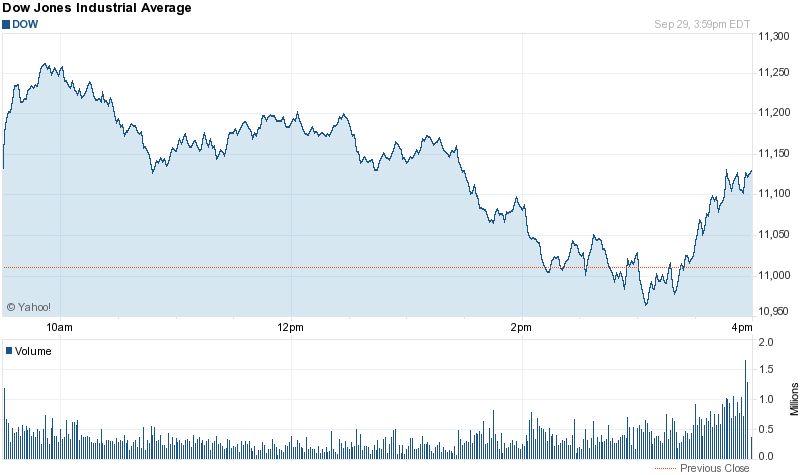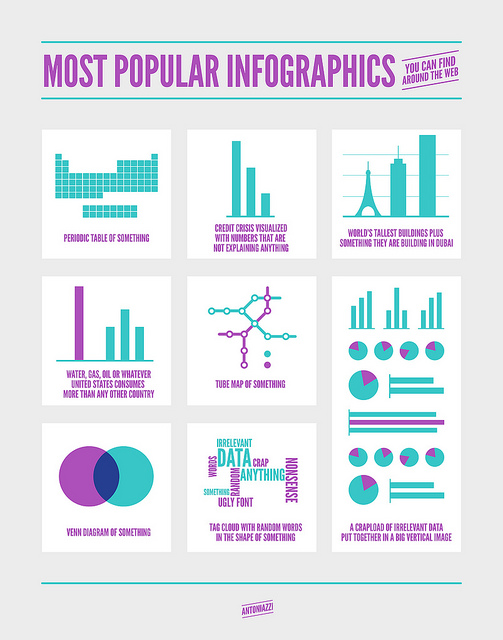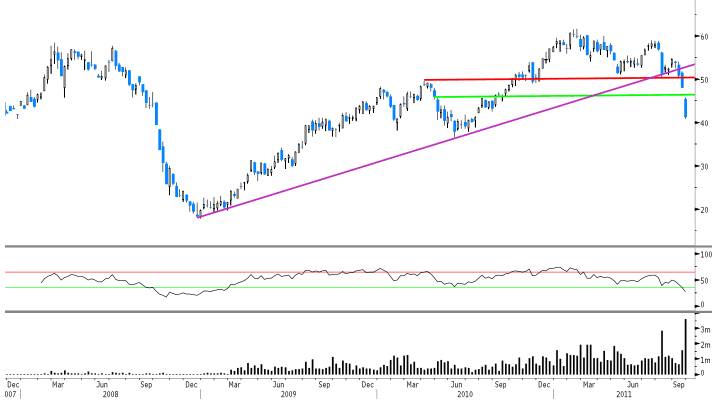The Big Picture | |
- Thursday Reading List
- Fun with Infographic Clichés
- Wall Street Week Retrospective
- Copper signaling recession ….
- End of the Quarter Rock & Roll!
- The Solyndra Loans as Liar’s Loans
- Big Surprise in Claims but…
- Gary Shilling Says U.S. Faces Deflation
- A Plaintive Plea From Mr. B?
- Dear Human . . .
| Posted: 29 Sep 2011 12:30 PM PDT Here is what I will be reading after ushering in the New Year :
What are you reading? > Oops! Spoke too soon. Here is what the closing Dow looked like 3pm chart is after the jump
Dow Jones Industrial Average — Intra-day reversal (plus 2.4% to flat) via Yahoo Finance |
| Posted: 29 Sep 2011 11:30 AM PDT |
| Wall Street Week Retrospective Posted: 29 Sep 2011 10:00 AM PDT |
| Posted: 29 Sep 2011 08:30 AM PDT FusionIQ’s Kevin Lane notes: Copper as seen on this weekly chart through last tick has broken two supports first near $ 50.00 (red line) and second (green line) near $ 46.00 – this free fall on volume is more indication that the market believes we are in a recession given copper's ties as an economic metal. > Copper Trend (2008-11)Source: FusionIQ |
| End of the Quarter Rock & Roll! Posted: 29 Sep 2011 06:26 AM PDT > Following yesterday’s ugly intra-day reversal, the futures are looking strong, with the fair value on the Dow at ~200 in the green. This is an oversold bear market bounce, and the odds favor its eventual exhaustion and reversal (there are internal metrics we can track which will help us identify if this run is the start of something more significant and lasting). The usual rationales from pundits hold little water. Consider the explanatories we have heard this morning:
My keys for today — aside from atoning for my many sins — is to watch the breadth, the volume, and of course, be wary for any late day reversals. Watch the markets when Europe closes. Perhaps most of all, keep an eye on the news. Not the news itself, but see how markets react to new news — that is far more important. This phase of the cycle is a trader’s market — not a buy & hold investor’s environment. To the nimble go the spoils. |
| The Solyndra Loans as Liar’s Loans Posted: 29 Sep 2011 06:15 AM PDT The Solyndra Loans as Liar's Loans > This column comments on Joe Nocera's September 23, 2011 column entitled: The Phony Solyndra Scandal Nocera's column compares the statements of Solyndra's controlling managers to Dick Fuld's statements to the public about Lehman's conditions and asserts with minimal explanation that neither could have been criminal. I have testified before the House Financial Services Committee at some length as to why Lehman was a "control fraud" so I disagree with Nocera. Lehman engaged in extensive accounting and securities fraud and caused massive losses by selling endemically fraudulent liar's loans to the secondary market. It Soyndra's controlling managers made false disclosures analogous to those made or permitted to go uncorrected by Fuld, then they too face a serious risk of criminal prosecution – it we ever replace Attorney General Holder with a prosecutor. I also write to explain why Nocera is wrong to absolve the White House from scandal in the Solyndra matter. Nocera argues that it is inherently highly risky for the government to lend to companies the market will not loan to because their "green" projects are extremely risky commercial projects. He concludes that it is inevitable that many such loans will fail and that such failures do not demonstrate that the federally subsidized loan program for green energy companies is flawed. He concludes by warning that China dominates solar panel manufacture and that China will be the winner if the Republicans cut funding for the green energy programs. Nocera is correct that the subsidized program is extremely risky. He identifies two of the risks. First, the technology developed may prove unmarketable. Second, entry by competitors may be so robust that the price of the relevant products (e.g., solar panels) suffer a "stunning collapse" and cause the U.S. Treasury-financed firm to fail even if the development of improved technology is modestly successful. There are obvious economic arguments against Nocera's play of the Red Menace card. China heavily subsidizes solar panel manufacturing. Other nations (including the U.S.) subsidize solar panel manufacturing. Solar panels are still a specialty application that is not cost-effective in general usage absent public subsidies. The subsidies to the purchasers are not large enough to develop a market that has kept pace with the tremendous growth of solar panel production. The result has been a glut of solar panel production and a sharp drop in solar panel prices. In sum, the Chinese government is taking the very large financial risks of developing a new technology and the financial losses that come from selling us the solar panels at a low and sharply falling price that is inadequate to defray the costs of production and the risks of new product development. Nocera states that China has provide a $30 billion subsidy to solar panel producers purchasers, which has helped produce a glut of solar panels and caused a "stunning collapse" in their "market" price. That means that the great bulk of the Chinese subsidy has flowed to purchasers of solar panels, including Americans. Even if the Chinese develop a solar panel technology that is cost effective in general residential and commercial real estate usage there is no assurance that the Chinese government or public will find the production subsidies desirable. China may lose its solar panel production lead to a lower-cost producer or a higher quality producer. Other nations' producers may be less than vigorous in enforcing the intellectual property rights of the Chinese producers, allowing domestic competitors to skip the large risks and costs of the research and development stage. This column, however, generally emphasizes financial regulation, and there are reasons to use the word "scandal" to describe the administration's treatment of its regulators in the Solyndra loan. Here is Nocera's defense of the administration's behavior:
Nocera's effort to minimize the administration's misconduct and his misstatements about risk are interrelated and they reprise the mistakes that the Bush administration made in its assault on financial regulation that led to the ongoing financial crisis. Life does not reward all risks. The quintessential risk that it does not reward in lending is failing to underwrite. A lender that fails to underwrite prudently is taking a severe risk, for the failure causes "adverse selection." Lenders that make large loans (e.g., mortgages or loans to solar panel manufacturers) under conditions of adverse selection have a "negative expected value" – they are gambling against the house. Lenders that make loans with a negative expected value will suffer severe losses. We are still suffering from a crisis driven by CEOs of lenders who deliberately destroyed essential underwriting in order to maximize the accounting control fraud "recipe" that I have explained many times. The result was "liar's" loans. By 2006, roughly half of loans called "subprime" were also liar's loans. Approximately one-third of U.S. mortgage loans made in 2006 were liar's loans and the fraud incidence in studies of liar's loans is 90 percent. Liar's loans caused staggering direct losses and hyper-inflated and extended the residential real estate bubble, driving the Great Recession. So the "real question" is not the one Nocera framed. The real question is why a lender (the U.S. government in this case) would gratuitously fail to underwrite a loan properly. The fact that the type of loan was inherently extremely risky makes it imperative that the lender engage is superb underwriting. The Obama administration, and Nocera, have failed to learn the most obvious and costly lesson of the ongoing U.S. crisis – liar's loans cause catastrophic losses and failures and are "an open invitation to fraudsters" (quoting MIRA's 2006 report to the members of the Mortgage Bankers Association). Nocera does not explain what is embarrassing about the Obama emails. The government's professional loan underwriters were worried about lending to Solyndra. They were warning the administration that they had not been able to complete the professional underwriting essential to making loans prudently. The Obama administration officials did not respond by backing their professional regulators. The administration did not stress that it was essential that the loan be approved only after it passed a rigorous underwriting process. The administration responded to the efforts of its professionals to protect the government from loss by abusing the regulators and pressuring them to approve the loans without completing the underwriting. The administration thought it was fine to make a liar's loan to Solyndra. The administration exposed the government to a gratuitous risk of loss of hundreds of millions of dollars in order to achieve an overarching priority – they wanted a presidential photo op. If that isn't a scandal, if Nocera thinks it is merely business as usual, then our failure to hold Dick Fuld, President Obama, and a host of other elites to a higher standard of accountability is the scandal that will generate repeated scandal. Bill Black is the author of The Best Way to Rob a Bank is to Own One and an associate professor of economics and law at the University of Missouri-Kansas City. He spent years working on regulatory policy and fraud prevention as Executive Director of the Institute for Fraud Prevention, Litigation Director of the Federal Home Loan Bank Board and Deputy Director of the National Commission on Financial Institution Reform, Recovery and Enforcement, among other positions. |
| Posted: 29 Sep 2011 06:05 AM PDT Initial Jobless Claims totaled 391k, 30k below estimates and down from 428k last week. It’s the lowest level since April but the Labor Department said, according to DJ, the sharp fall was due to “technical issues and seasonal adjustment volatility, rather than economic factors.” Since there weren’t any holidays over the past few weeks I’m not sure what issues the Labor Dept could have had but I guess we’ll have to wait until next week to get a better feel. Continuing Claims were in line but Extended Benefits rose a net 75k. Bottom line, while the market responded well to the Initial Claims print, the Labor Dept caveat shouldn’t be ignored. Unfortunately though we’ll have to wait until next Thursday to see whether a new positive trend is being established or today was a technical anomaly. |
| Gary Shilling Says U.S. Faces Deflation Posted: 29 Sep 2011 05:45 AM PDT |
| Posted: 29 Sep 2011 05:23 AM PDT Art Cashin of UBS looks at the Q&A portion following Fed Chairman Bernard Bernanke’s Cleveland speech last night. Regardless of what you thought of the speech (Lessons from Emerging Market Economies on the Sources of Sustained Growth) it was the Q&A that produced the stir. Via the Associated Press, here is a brief report on the event:
Art notes that “there was even a line that might be seen as a cross between ‘I've done my job’ and ‘we're plumb out of bullets’ “:
> Sources: Bernanke: Long-term unemployment a national crisis Yahoo Finance version |
| Posted: 29 Sep 2011 04:51 AM PDT |
| You are subscribed to email updates from The Big Picture To stop receiving these emails, you may unsubscribe now. | Email delivery powered by Google |
| Google Inc., 20 West Kinzie, Chicago IL USA 60610 | |






